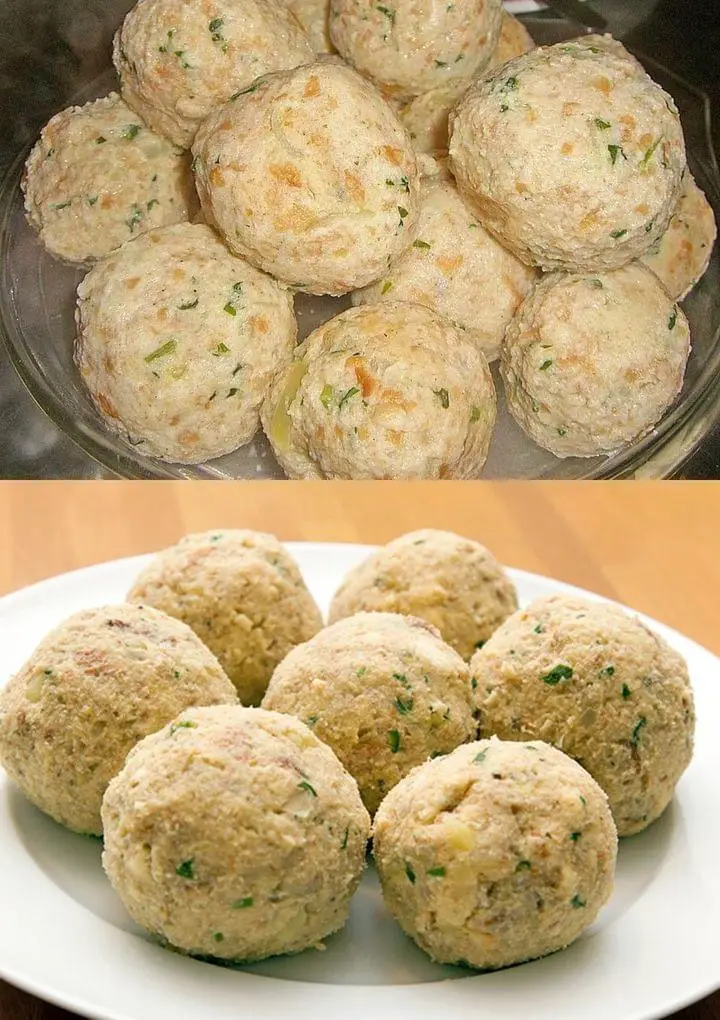Semmelknödel – The Best Recipe Ever 🍞✨
Ingredients
- 500 g stale rolls (bread rolls)
- 250 ml milk
- 1 onion
- 2 tbsp butter
- 3 eggs
- 100 g flour
- Salt and pepper, to taste
- Fresh parsley, chopped
Instructions
1. Prepare the Bread Rolls:
Cut the stale rolls into small cubes and place them in a large mixing bowl. 🍞
2. Warm the Milk:
Heat the milk until warm, then pour it over the bread cubes. Mix well and let it soak for about 10 minutes.
3. Sauté the Onion:
Finely chop the onion and sauté it in butter until translucent. Add the sautéed onion to the bread mixture.
4. Mix the Dough:
Add the eggs, flour, salt, pepper, and chopped parsley to the soaked bread mixture. Mix everything thoroughly until combined.
5. Shape the Dumplings:
With damp hands, form the mixture into evenly sized dumplings.
6. Cook the Dumplings:
Place the dumplings into gently simmering salted water. Let them cook for about 15-20 minutes or until they float to the surface.
7. Serve:
Remove the dumplings from the water and let them drain. Serve with your favorite sauce or alongside meat dishes. 🌿
Pro Tip:
If you enjoy this recipe, don’t forget to follow for more delicious ideas! 🥳
FAQs About Bread Dumplings (Semmelknödel)
1. What are Semmelknödel?
Semmelknödel are traditional German bread dumplings made from day-old bread, milk, eggs, and seasonings. They are a popular side dish served with hearty meals like roasts or stews.
2. Can I use fresh bread instead of stale bread?
Yes, you can use fresh bread, but stale bread works better as it absorbs the liquid without becoming overly mushy. If using fresh bread, consider lightly toasting the cubes first.
3. How do I prevent the dumplings from falling apart?
Ensure the dough is well combined and not too wet. If the mixture feels too sticky, add a little more flour. Forming the dumplings with slightly damp hands also helps.
4. Can I freeze Semmelknödel?
Yes, you can freeze them before or after cooking. To freeze uncooked dumplings, shape them and place them on a tray in the freezer. Once frozen, transfer them to a freezer-safe bag. Cook them directly from frozen. For cooked dumplings, let them cool completely before freezing, then reheat in boiling water or a steamer.
5. Are Semmelknödel vegetarian?
The basic recipe is vegetarian. However, ensure the accompanying dishes or sauces are vegetarian-friendly if that’s your preference.
6. What can I serve with Semmelknödel?
Semmelknödel pair well with gravies, roasted meats, sauerkraut, or creamy mushroom sauces. They also work as a side for goulash or hearty vegetable stews.
7. Can I make Semmelknödel gluten-free?
Yes, by using gluten-free bread and substituting regular flour with gluten-free flour, you can create gluten-free Semmelknödel.
8. How do I store leftovers?
Store cooked Semmelknödel in an airtight container in the refrigerator for up to 3 days. Reheat them in boiling water, a steamer, or the microwave.
9. Why do my dumplings turn out too dense?
Dense dumplings may result from overmixing or not soaking the bread long enough. Allow the bread to absorb the milk fully and mix just until combined.
10. Can I add extra flavors to the dough?
Absolutely! You can incorporate sautéed mushrooms, crispy bacon, grated cheese, or nutmeg for added flavor. Customize the recipe to your taste preferences!

